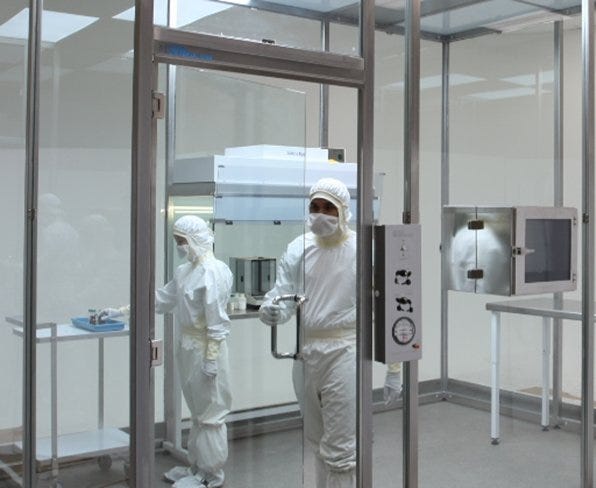Particles, particles everywhere! What is a lab to do? Sources of these contaminating specks are many: equipment, room materials, unfiltered air, bacteria and mold, clothing, and (the biggest culprit of all) people. Facilities make heroic efforts to keep the adulterants at bay, but some amount of contaminants will find their way into the controlled space.
Until processes become fully automated, personnel will still need to step into cleanrooms to perform application-specific tasks and service equipment. Best practices guide these workers, but it’s impossible to contain every particle that’s just begging to float around the room or land on surfaces.
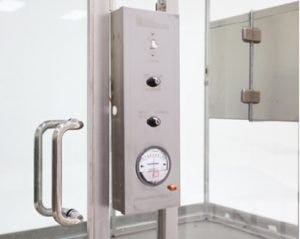
Control panel with pressure gauge and power switches for lights and fan/filter units.
Clean Materials
Equipment is getting cleaner, with components like brush-less motors that reduce contact friction and the resulting erosion (which generates particles). Cleanroom clothing has also advanced in the last few years with lint-free materials and disposable garments.
So, what of the cleanroom itself? Fan/Filter Units (FFUs) with very efficient HEPA or ULPA filters are installed to remove particles from the circulating air. In a perfect world, that would solve the problem, however some cleanroom building materials contribute to the particle load. Chrome-plated room components such as hardware, for example, are sometimes used. Over time, these articles may wear and slough small fragments; exposed metal can corrode, rust and shed. Another example: porous acrylic retains moisture, which breeds bacteria and airborne mold spores.
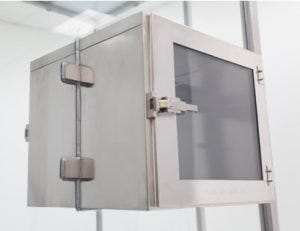
Stainless steel pass-through chamber installed in tempered glass wall panel.
How can you get a step closer to the ultimate clean room? Terra Universal now manufactures wall panels made of tempered glass assembled to a 304 stainless steel frame using steel fasteners. Both glass and stainless steel are non-porous, non-shedding and non-outgassing. What could be cleaner?! The modular BioSafe® Tempered Glass Cleanroom is free-standing, using a sturdy frame made of two-inch square tubes. The steel ceiling grid supports lighting and FFU modules, controlled by a central panel that allows power ON/OFF and night-service mode (lower FFU speed to conserve energy during non-working hours).
The BioSafe room holds pressure, meets cleanliness requirements down to ISO 5, and is ideal for aseptic applications requiring frequent sterilization. Our acrylic example from above is applicable here: acrylic is easily damaged by alcohol and other common cleaning agents. Glass and stainless steel, on the other hand, readily tolerate these chemicals. In fact, the room stands up to disinfecting power washes! See the demonstration video on the product page.
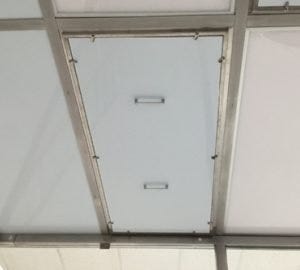
Ceiling module cover protect electrical components and delicate filters
Power-Wash a Cleanroom? Yes!
When spraying powerful jets of purified water onto the ceiling, it’s prudent to protect the electrical components from streams of water. Terra makes polypropylene panel covers that clip to the ceiling grid and cover the modules. Sterilizing chemicals are applied first, using cleanroom best practices: start at the ceiling and work your way down. Let gravity help force the impurities down to the floor for easier removal.
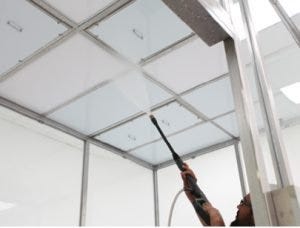
Power wash spray-down sterilizes Tempered Glass Cleanroom
Then a powerful rinse of purified water removes the strong chemicals. Wipe down is the last step; at this time, cleanroom personnel want to don cleanroom-approved garments to cover clothing, hair and face. This prevents the introduction of new contaminants into the freshly sterilized room. Workers use squeegees and lint-free wipes to complete the sterilization process.
Modular cleanrooms like this one can be built in almost any custom size and room quantity to fit your footprint and application requirements. Depending on the cleanliness rating you need, Terra can help calculate the number and location of fan/filter units, and suggest other modules such as UV sanitizing lights and ionization bars. Click here for more information about Terra’s BioSafe Tempered Glass Cleanroom.



